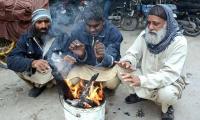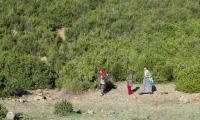One of the unfortunate collateral damages of the digital communication revolution is the virtual disappearance of old-fashioned, on-paper letters and postcards from our lives.
I work in an office where, occasionally, one comes in contact with foreigners – including, once in a while, the good folks from ‘the West’ whom we complexion-obsessed Pakistanis collectively and admiringly call the goras. While we may have given up on snail mail altogether, the goras are fortunately still willing to send out a card or two, at least during what they call the festive season. The greeting card that has inspired this piece comes from ‘Dear Bryan’, who happens to be ‘doing time’ in Islamabad in the service of his country – which might, in a parallel universe, be called the ‘Great White North’.
Bryan’s card has cried out for attention ever since it landed on my table sometime before Christmas and I keep staring at the photograph that constitutes the front or the face of the card. To a Pakistani, it is a boring scene depicting a divided city road in some nondescript town with a bunch of people and vehicles scattered across the frame. I keep wondering why a Western embassy would choose this view – which to us natives appears very bland – as a representative landscape of Pakistan worthy of adorning a card that will be circulated far and wide?
It turns out that the answer has been right before my eyes. The banal photo is, in fact, full of the negative stereotypes that are usually associated with Pakistan. It reinforces the thinly disguised Western perceptions about our country that belong to the 12th century rather than to the 21st. It is, from the point of view of the sender, a note from a place that is quite unlike home. The selected scene, therefore, contains and conveys all the shock value that you would expect from a postcard from the edge of civilisation.
I must make a confession here: I don’t remember when or where I met Bryan or what he looks like. I must have met him at a seminar or conference where we probably ended up exchanging cards. I just cannot differentiate him from the other pale faces that I have come across over the last few months. While I may not recall what ‘Dear Bryan’ looks like, I do admire the country that he hails from – even though I have never set foot in it.
The Great White North is an ‘at-peace’ and very tolerant democracy that cares greatly about the welfare of its own citizens while keeping its doors open for immigrants from around the world – whether it includes those who have had to flee from their homes due to violence and conflict or young people with useful skills who are looking to improve their lives in a rich, capitalist economy.
So, what does this card from a nice guy who hails from a nice country tell us about how our gora friends view and want to depict Pakistan? For one, it suggests that Pakistan either has no women or that women are completely absent from public life. Of the dozens of people clearly visible in the picture, not one is female. I suppose this presumed absence of women from public life must dovetail nicely with the Western fiction that suggests terrorism exists in this country because most Pakistani young men are just dying to go to heaven and claim their 72 virgins.
Let alone show an actual female face, there is not even a shuttlecock burqa in sight in this picture that was taken on a busy city street. Our foreign friends must believe that ‘this’ is the true Pakistan and that ‘the other’ Pakistan – in which women become prime ministers, ministers, editors and anchors, ambassadors and bureaucrats; run business companies; outperform men in academic achievements; and enter the workforce in droves – is a figment of some reluctant columnist’s imagination.
While the Elon Musks and Teslas of this world are almost ready to bring self-driving electric cars to the doorstep of the average Western consumer, ‘Dear Bryan’ believes Pakistan remains stuck in the days of animal-driven carts; multiple such Mohenjodaro-era contraptions adorn the postcard I was sent.
Looking at the postcard, we could certainly be forgiven for thinking that Pakistan does not have many cars. Only two of these vehicles are small cars that are stuck behind animal carts. The card tells us that the auto rickshaw is king in Pakistan – almost 10 vehicles in the card, including the most prominent one closest to the lens, are rickshaws. Now why can’t I remember the last time I sat in one?
Finally, the card reveals to all those lucky enough to get their hands on it – including perhaps those who are sitting somewhere in the policymaking offices in the ‘Great White North’ itself – that the typical Pakistani looks exactly like the Taliban depicted in the video clips, which are staple ingredient in Western media’s ‘Af-Pak’ coverage. For example, not only are all the people shown on the greeting card men, but all of them also sport Taliban-style beards. The most prominent person shown on the card, closest to the lens and in the centre of the picture, ‘appears’ to have a beard that is almost a foot long. Gillette must have thrown in the towel long ago and gotten the hell out of Dodge.
Another not-so-modern invention which, according to the card, has yet to breach our fortified geographical and ideological frontiers are the Western-style men’s trousers – all of the dozens of men in this purported snapshot of Pakistan are wearing baggy shalwar kameez – again a standard fare for the Taliban.
The postcard has one final touch for the discerning eye – banners that advertise a Jamaat-e-Islami Convention. They may not be in English and are largely facing away from the camera’s point of view. But the inclusion of an advertisement for this convention has to be the icing on the cake for a 3x5 inch piece of paper loaded with symbolism about Pakistan where women are supposedly invisible in public life and everyone looks and dresses like the Taliban.
Of course, the photo is neither staged nor has it been tampered with. But for our foreign friends to choose this particular ‘Taliban country’ scene over a million other possible representations of Pakistan – including those which show the dynamic and progressive dimensions of this country – betrays the deeply-held stereotypes about Pakistan and how such views get reinforced and propagated.
Email: thereluctantcolumnist@ gmail.com
There are over 11 million Pakistanis settled abroad, out of which around six million work in Gulf and Middle East
This year alone, US Treasury would have to roll-over $10 to $14 trillion in maturing short-term debt
Tear gas no longer marks just protest sites; it paints entire cities as battlegrounds but then again, PTI did it first
Political structures and governance systems have been central to economic and social development
It is confirmed now 40 Pakistanis had died after boat of migrants had capsized in sea near Greece
Many people believe that in future, AI will play an even more significant role in their lives







